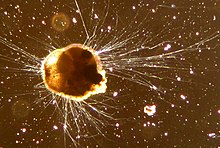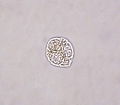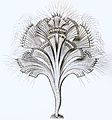| Revision as of 19:58, 27 July 2021 editTom.Reding (talk | contribs)Autopatrolled, Extended confirmed users, Page movers, Template editors3,874,402 editsm General & WP:TOL cleanup; WP:GenFixes onTag: AWB← Previous edit |
Revision as of 16:10, 16 September 2021 edit undoCitation bot (talk | contribs)Bots5,428,944 edits Add: pmid, issue, doi-access, authors 1-1. Removed proxy/dead URL that duplicated identifier. Removed parameters. Some additions/deletions were parameter name changes. | Use this bot. Report bugs. | Suggested by Headbomb | Linked from Misplaced Pages:WikiProject_Academic_Journals/Journals_cited_by_Wikipedia/Sandbox | #UCB_webform_linked 445/835Next edit → |
| Line 15: |
Line 15: |
|
}} |
|
}} |
|
|
|
|
|
The '''Rhizaria''' are a species-rich supergroup of mostly ]<ref>{{cite web | url = http://www.palaeos.com/Eukarya/Units/Rhizaria/Rhizaria.html | year = 2004 | author = Christopher Taylor | title = Rhizaria | url-status = dead | archive-url = https://web.archive.org/web/20090420034036/http://www.palaeos.com/Eukarya/Units/Rhizaria/Rhizaria.html | archive-date = 2009-04-20 }}</ref> ]s.<ref name="pmid15148395">{{cite journal |vauthors=Nikolaev SI, Berney C, Fahrni JF, etal |title=The twilight of Heliozoa and rise of Rhizaria, an emerging supergroup of amoeboid eukaryotes |journal=Proc. Natl. Acad. Sci. U.S.A. |volume=101 |issue=21 |pages=8066–71 |date=May 2004 |pmid=15148395 |pmc=419558 |doi=10.1073/pnas.0308602101 }}</ref> Except for the ] and three species in the genus ] in the phylum ], they are all non-photosynthethic, but many foraminifera and radiolaria have a symbiotic relationship with unicellular algae.<ref>{{Cite journal|last1=Gast|first1=Rebecca J.|last2=Caron|first2=David A.|date=2001-10-01|title=Photosymbiotic associations in planktonic foraminifera and radiolaria|journal=Hydrobiologia|language=en|volume=461|issue=1|pages=1–7|doi=10.1023/A:1012710909023|s2cid=1387879|issn=1573-5117}}</ref> A multicellular form, ''Guttulinopsis vulgaris'', a cellular ], has also been described.<ref>{{cite journal | url=http://www.cell.com/current-biology/abstract/S0960-9822(12)00413-7 | year = 2012 | author = Brown| title = Aggregative Multicellularity Evolved Independently in the Eukaryotic Supergroup Rhizaria |display-authors=etal | doi=10.1016/j.cub.2012.04.021 | volume=22 | issue = 12 | journal=Current Biology | pages=1123–1127 | pmid=22608512| doi-access=free }}</ref> |
|
The '''Rhizaria''' are a species-rich supergroup of mostly ]<ref>{{cite web | url = http://www.palaeos.com/Eukarya/Units/Rhizaria/Rhizaria.html | year = 2004 | author = Christopher Taylor | title = Rhizaria | url-status = dead | archive-url = https://web.archive.org/web/20090420034036/http://www.palaeos.com/Eukarya/Units/Rhizaria/Rhizaria.html | archive-date = 2009-04-20 }}</ref> ]s.<ref name="pmid15148395">{{cite journal |vauthors=Nikolaev SI, Berney C, Fahrni JF, etal |title=The twilight of Heliozoa and rise of Rhizaria, an emerging supergroup of amoeboid eukaryotes |journal=Proc. Natl. Acad. Sci. U.S.A. |volume=101 |issue=21 |pages=8066–71 |date=May 2004 |pmid=15148395 |pmc=419558 |doi=10.1073/pnas.0308602101 |doi-access=free }}</ref> Except for the ] and three species in the genus ] in the phylum ], they are all non-photosynthethic, but many foraminifera and radiolaria have a symbiotic relationship with unicellular algae.<ref>{{Cite journal|last1=Gast|first1=Rebecca J.|last2=Caron|first2=David A.|date=2001-10-01|title=Photosymbiotic associations in planktonic foraminifera and radiolaria|journal=Hydrobiologia|language=en|volume=461|issue=1|pages=1–7|doi=10.1023/A:1012710909023|s2cid=1387879|issn=1573-5117}}</ref> A multicellular form, ''Guttulinopsis vulgaris'', a cellular ], has also been described.<ref>{{cite journal | year = 2012 | author = Brown| title = Aggregative Multicellularity Evolved Independently in the Eukaryotic Supergroup Rhizaria |display-authors=etal | doi=10.1016/j.cub.2012.04.021 | volume=22 | issue = 12 | journal=Current Biology | pages=1123–1127 | pmid=22608512| doi-access=free }}</ref> |
|
This supergroup was proposed by ] in 2002. Being described mainly from ] sequences, they vary considerably in form, having no clear morphological distinctive characters (]), but for the most part they are ]s with filose, reticulose, or microtubule-supported ]s. The Rhizaria’s pseudopodial mineral skeleton network, which is made up of opal (SiO₂), celestite (SrSO₄), or calcite (CaCO₃), is what differentiates it from the amoebae. It can attain sizes of more than a centimeter with some species being able to form cylindrical colonies approximately 1 cm in diameter and greater than 1 m in length. They feed by capturing and engulfing prey within the extensions of their pseudopodial skeletons, and some even become homes for algae, which aid in boosting the total primary production of the ocean.<ref>Caron, D. (2016). The rise of Rhizaria. Nature (London), 532(7600), 444–445. https://doi.org/10.1038/nature17892</ref> |
|
This supergroup was proposed by ] in 2002. Being described mainly from ] sequences, they vary considerably in form, having no clear morphological distinctive characters (]), but for the most part they are ]s with filose, reticulose, or microtubule-supported ]s. The Rhizaria’s pseudopodial mineral skeleton network, which is made up of opal (SiO₂), celestite (SrSO₄), or calcite (CaCO₃), is what differentiates it from the amoebae. It can attain sizes of more than a centimeter with some species being able to form cylindrical colonies approximately 1 cm in diameter and greater than 1 m in length. They feed by capturing and engulfing prey within the extensions of their pseudopodial skeletons, and some even become homes for algae, which aid in boosting the total primary production of the ocean.<ref>Caron, D. (2016). The rise of Rhizaria. Nature (London), 532(7600), 444–445. https://doi.org/10.1038/nature17892</ref> |
|
|
|
|
| Line 40: |
Line 40: |
|
}}</ref> who also included the ]s and ]. |
|
}}</ref> who also included the ]s and ]. |
|
|
|
|
|
Another order that appears to belong to this taxon is the ].<ref name=Hartikainen2014>{{cite journal | last1 = Hartikainen | first1 = H | last2 = Stentiford | first2 = GD | last3 = Bateman | first3 = KS | last4 = Berney | first4 = C | last5 = Feist | first5 = SW | last6 = Longshaw | first6 = M | last7 = Okamura | first7 = B | last8 = Stone | first8 = D | last9 = Ward | first9 = G | last10 = Wood | first10 = C | last11 = Bass | first11 = D | year = 2014 | title = Mikrocytids are a broadly distributed and divergent radiation of parasites in aquatic invertebrates | url =https://nhm.openrepository.com/bitstream/10141/622246/1/Mikrocytids_CurrBiol_2014.pdf | journal = Curr Biol | volume = 24 | issue = 7| pages = 807–12 | doi = 10.1016/j.cub.2014.02.033 | pmid=24656829| s2cid = 17180719 | doi-access = free }}</ref> These are parasites of ]s. This includes the causative agent of Denman Island Disease, ''Mikrocytos mackini'' a small (2−3 μm diameter) amitochondriate protistan.<ref>{{Cite journal|last=Hine|first=Pm|last2=Bower|first2=Sm|last3=Meyer|first3=Gr|last4=Cochennec-Laureau|first4=N|last5=Berthe|first5=Fcj|date=2001|title=Ultrastructure of Mikrocytos mackini, the cause of Denman Island disease in oysters Crassostrea spp. and Ostrea spp. in British Columbia, Canada|url=http://www.int-res.com/abstracts/dao/v45/n3/p215-227/|journal=Diseases of Aquatic Organisms|language=en|volume=45|pages=215–227|doi=10.3354/dao045215|issn=0177-5103|doi-access=free}}</ref> |
|
Another order that appears to belong to this taxon is the ].<ref name=Hartikainen2014>{{cite journal | last1 = Hartikainen | first1 = H | last2 = Stentiford | first2 = GD | last3 = Bateman | first3 = KS | last4 = Berney | first4 = C | last5 = Feist | first5 = SW | last6 = Longshaw | first6 = M | last7 = Okamura | first7 = B | last8 = Stone | first8 = D | last9 = Ward | first9 = G | last10 = Wood | first10 = C | last11 = Bass | first11 = D | year = 2014 | title = Mikrocytids are a broadly distributed and divergent radiation of parasites in aquatic invertebrates | url =https://nhm.openrepository.com/bitstream/10141/622246/1/Mikrocytids_CurrBiol_2014.pdf | journal = Curr Biol | volume = 24 | issue = 7| pages = 807–12 | doi = 10.1016/j.cub.2014.02.033 | pmid=24656829| s2cid = 17180719 | doi-access = free }}</ref> These are parasites of ]s. This includes the causative agent of Denman Island Disease, ''Mikrocytos mackini'' a small (2−3 μm diameter) amitochondriate protistan.<ref>{{Cite journal|last1=Hine|first1=Pm|last2=Bower|first2=Sm|last3=Meyer|first3=Gr|last4=Cochennec-Laureau|first4=N|last5=Berthe|first5=Fcj|date=2001|title=Ultrastructure of Mikrocytos mackini, the cause of Denman Island disease in oysters Crassostrea spp. and Ostrea spp. in British Columbia, Canada|url=http://www.int-res.com/abstracts/dao/v45/n3/p215-227/|journal=Diseases of Aquatic Organisms|language=en|volume=45|issue=3|pages=215–227|doi=10.3354/dao045215|pmid=11558731|issn=0177-5103|doi-access=free}}</ref> |
|
|
|
|
|
==Evolutionary relationships== |
|
==Evolutionary relationships== |
| Line 47: |
Line 47: |
|
|
|
|
|
Historically, many rhizarians were considered ]s because of their motility and ]. However, when a simple animal-plant dichotomy was superseded by a recognition of additional kingdoms, taxonomists generally placed Rhizarians in the kingdom ]. When scientists began examining the evolutionary relationships among eukaryotes using molecular data, it became clear that the kingdom ] was ]. Rhizaria appear to share a common ancestor with ] and ] forming part of the SAR (Stramenopiles+Alveolates+Rhizaria) super assemblage.<ref>{{cite journal | title = Phylogenomics Reshuffles the Eukaryotic Supergroups| journal = ]| year = 2007 | volume = 2 | pages = e790– | issue = 8| doi = 10.1371/journal.pone.0000790 | pmid = 17726520 | last1 = Burki | first1 = F| last2 = Shalchian-Tabrizi | first2 = K | last3 = Minge | first3 = M | last4 = Skjaeveland | first4 = A | last5 = Nikolaev | first5 = SI | last6 = Jakobsen | first6 = KS | last7 = Pawlowski | first7 = J | pmc = 1949142 | editor1-last = Butler | editor1-first = Geraldine |
|
Historically, many rhizarians were considered ]s because of their motility and ]. However, when a simple animal-plant dichotomy was superseded by a recognition of additional kingdoms, taxonomists generally placed Rhizarians in the kingdom ]. When scientists began examining the evolutionary relationships among eukaryotes using molecular data, it became clear that the kingdom ] was ]. Rhizaria appear to share a common ancestor with ] and ] forming part of the SAR (Stramenopiles+Alveolates+Rhizaria) super assemblage.<ref>{{cite journal | title = Phylogenomics Reshuffles the Eukaryotic Supergroups| journal = ]| year = 2007 | volume = 2 | pages = e790– | issue = 8| doi = 10.1371/journal.pone.0000790 | pmid = 17726520 | last1 = Burki | first1 = F| last2 = Shalchian-Tabrizi | first2 = K | last3 = Minge | first3 = M | last4 = Skjaeveland | first4 = A | last5 = Nikolaev | first5 = SI | last6 = Jakobsen | first6 = KS | last7 = Pawlowski | first7 = J | pmc = 1949142 | editor1-last = Butler | editor1-first = Geraldine |
|
| bibcode = 2007PLoSO...2..790B}}</ref> Rhizaria has been supported by molecular phylogenetic studies as a monophyletic group.<ref name=Burki2008>{{cite journal|last1=Burki |first1=Fabien |last2=Shalchian-Tabrizi |first2=Kamran |last3=Pawlowski |first3=Jan |title=Phylogenomics reveals a new 'megagroup' including most photosynthetic eukaryotes |journal=Biology Letters |date=August 23, 2008 |doi=10.1098/rsbl.2008.0224 |pmid=18522922 |volume=4 |issue=4 |pmc=2610160 |pages=366–9}}</ref> Biosynthesis of ] precursors in various rhizaria<ref>{{Cite journal|last1=Hallmann|first1=Christian|last2=Stuhr|first2=Marleen|last3=Kucera|first3=Michal|last4=Zonneveld|first4=Karin|last5=Bobrovskiy|first5=Ilya|last6=Bowser|first6=Samuel S.|last7=Pawlowski|first7=Jan|last8=Deckker|first8=Patrick De|last9=Nowack|first9=Eva C. M.|date=2019-03-04|title=Putative sponge biomarkers in unicellular Rhizaria question an early rise of animals|journal=Nature Ecology & Evolution|volume=3|issue=4|language=en|pages=577–581|doi=10.1038/s41559-019-0806-5|pmid=30833757|s2cid=71148672|issn=2397-334X}}</ref> suggests a relevant ecological role already during the ]. |
|
| bibcode = 2007PLoSO...2..790B| doi-access = free}}</ref> Rhizaria has been supported by molecular phylogenetic studies as a monophyletic group.<ref name=Burki2008>{{cite journal|last1=Burki |first1=Fabien |last2=Shalchian-Tabrizi |first2=Kamran |last3=Pawlowski |first3=Jan |title=Phylogenomics reveals a new 'megagroup' including most photosynthetic eukaryotes |journal=Biology Letters |date=August 23, 2008 |doi=10.1098/rsbl.2008.0224 |pmid=18522922 |volume=4 |issue=4 |pmc=2610160 |pages=366–9}}</ref> Biosynthesis of ] precursors in various rhizaria<ref>{{Cite journal|last1=Hallmann|first1=Christian|last2=Stuhr|first2=Marleen|last3=Kucera|first3=Michal|last4=Zonneveld|first4=Karin|last5=Bobrovskiy|first5=Ilya|last6=Bowser|first6=Samuel S.|last7=Pawlowski|first7=Jan|last8=Deckker|first8=Patrick De|last9=Nowack|first9=Eva C. M.|date=2019-03-04|title=Putative sponge biomarkers in unicellular Rhizaria question an early rise of animals|journal=Nature Ecology & Evolution|volume=3|issue=4|language=en|pages=577–581|doi=10.1038/s41559-019-0806-5|pmid=30833757|s2cid=71148672|issn=2397-334X}}</ref> suggests a relevant ecological role already during the ]. |
|
|
|
|
|
===Phylogeny=== |
|
===Phylogeny=== |
A few other groups may be included in the Cercozoa, but some trees appear closer to the Foraminifera. These are the Phytomyxea and Ascetosporea, parasites of plants and animals, respectively, and the peculiar amoeba Gromia. The different groups of Rhizaria are considered close relatives based mainly on genetic similarities, and have been regarded as an extension of the Cercozoa. The name Rhizaria for the expanded group was introduced by Cavalier-Smith in 2002, who also included the centrohelids and Apusozoa.
In 2019, the Cercozoa were recognized as a basal Rhizaria group, as sister of the Retaria.

 Cercomonas sp. (Cercozoa: Cercomonadida
Cercomonas sp. (Cercozoa: Cercomonadida
 Ebria sp. (Cercozoa: Ebridea)
Ebria sp. (Cercozoa: Ebridea)
 Rhipidodendron sp. (Cercozoa: Spongomonadea)
Rhipidodendron sp. (Cercozoa: Spongomonadea)
 Euglypha sp. (Cercozoa: Euglyphida)
Euglypha sp. (Cercozoa: Euglyphida)
 Phaeodarians (Cercozoa: Phaeodarea)
Phaeodarians (Cercozoa: Phaeodarea)
 Clathrulina elegans (Cercozoa: Granofilosea: Desmothoracida)
Clathrulina elegans (Cercozoa: Granofilosea: Desmothoracida)
 Chlorarachnion sp. (Cercozoa: (Chlorarachniophyta)
Chlorarachnion sp. (Cercozoa: (Chlorarachniophyta)
 Vampyrella sp. (Cercozoa: Vampyrellidae)
Vampyrella sp. (Cercozoa: Vampyrellidae)
 Gromia (Cercozoa: Gromiidea)
Gromia (Cercozoa: Gromiidea)
 Powdery scab (Cercozoa: Plasmodiophorida)
Powdery scab (Cercozoa: Plasmodiophorida)
 Foraminiferans (Retaria: Foraminifera)
Foraminiferans (Retaria: Foraminifera)
 Polycystines (Retaria: Radiolaria)
Polycystines (Retaria: Radiolaria)
 Acantharians (Retaria: Radiolaria)
Acantharians (Retaria: Radiolaria)